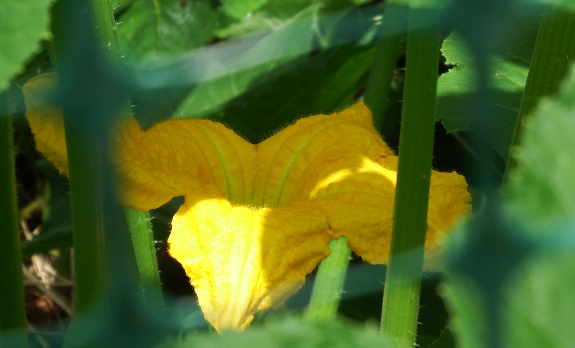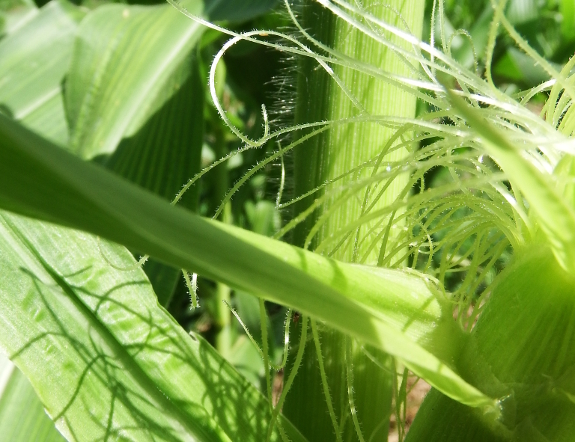
archives for 06/2017
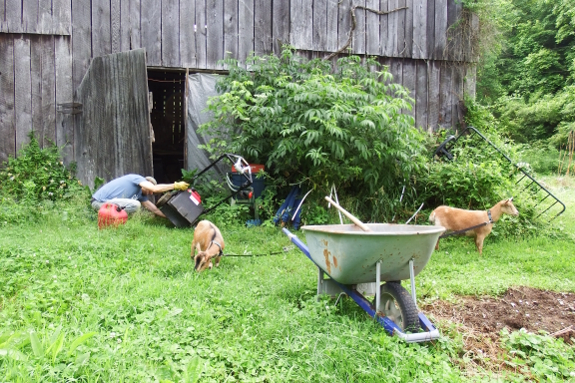
I caught this shot
yesterday of the crew gearing up for a day of lawn mowing. Mark was
cleaning grass out of the
Honda in preparation for some heavy mower action while the herd was
getting ready to chow down. Too bad I didn't take an after photo to
show what a great job our trio of lawn mowers did!
Joey was asking how many
watts can we expect with these solar panels?
Each 15 watt Amorphous panel
puts out about 20 volts DC that goes into a voltage regulator to bring
it down to 13 volts x 2.25 amps=29 watts under the best conditions.
The bad news is the biggest
battery it can handle is one of those little ATV batteries around 20 to
30 AH which crushes my plans of using it to charge up 2 golf cart
batteries.
It's on us for not doing the
proper research before we bought these. I think a better value would be
to find a 50 watt Poly-Crystaline panel with a 10 amp charge controller
for less than what these sell for. Another thing bad about Amorphous
panels is that they are only expected to last 5 to 8 years.
The new plan is to come up with some sort of Art project that makes use
of these in some fashion. We've got another kit in the barn with 3 more
panels.
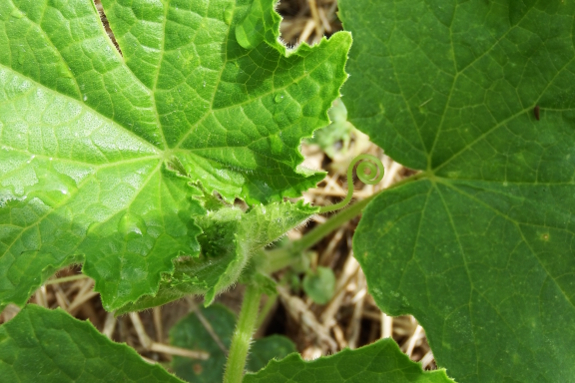
By the beginning of
June, the shape of the rest of the garden year is beginning to ossify.
In a perfect world, the gardener was smart enough to plant only what
she could easily manage, so spring crops are in full production while
summer crops are growing quickly beneath their mostly weed-free mulch.
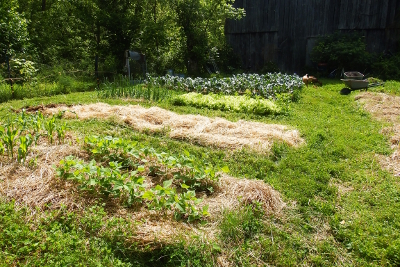 This year, I'm quite pleased
with the state of my active beds. In contrast, I was starting to get
sick at this time last year, and I let large swathes of the garden run
away from me. The result is still being felt twelve months later when
perennials (primarily strawberries and asparagus) produce at rates a
quarter to half of normal while as much of a third of previously
cultivated ground currently lies weedily fallow.
This year, I'm quite pleased
with the state of my active beds. In contrast, I was starting to get
sick at this time last year, and I let large swathes of the garden run
away from me. The result is still being felt twelve months later when
perennials (primarily strawberries and asparagus) produce at rates a
quarter to half of normal while as much of a third of previously
cultivated ground currently lies weedily fallow.
Luckily, solutions are
simple. I'm slowly solarizing the troubled spots, then will plant them
in buckwheat to bring the areas back into production a bit richer than
I found them. Meanwhile, extra weeding jobs on the perennials will do
the same for our beloved strawberries and asparagus. Slowly but surely,
the effects of being an overzealous gardener with an underzealous
energy level will disappear into our rear-view mirror as our previously
problematic garden comes back to life.
This old section of an
antenna pole is just barely big enough for a rain barrel.
Two ratchet straps will keep
it from moving side to side.
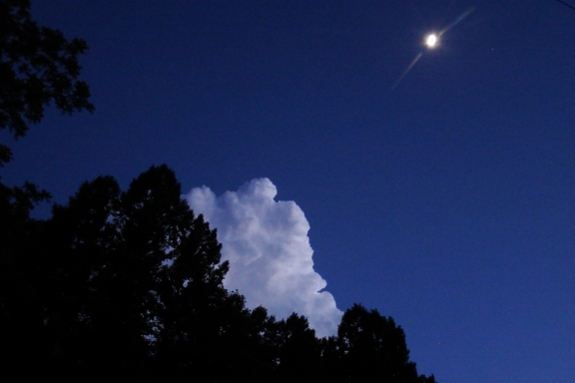
I went outside the other
night just as day was turning into night and caught these huge clouds
shining against darkened trees.

I suspect the clouds
must have been catching reflections of the recently vanished sun. Or
maybe the half moon was bright enough to give them that pillowy glow?
Whatever the reason, I had to rush back inside for the camera so I
could share the beauty.
I definitely need to
remember to go outside more often during the gloaming!
Learning Anna's goat routine was easy once Edgar stopped being afraid of me.
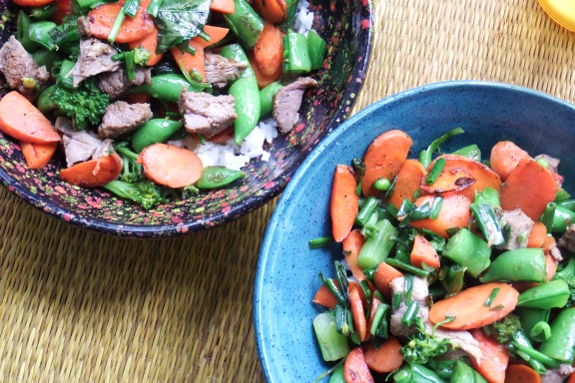
I thought you might
enjoy two of my newest hand-made bowls in action. As usual, they're
imperfect...but still beautiful and functional.
The real purpose of this
post, though, is to let you know I'm going on a writer's retreat this
afternoon and won't be back at on the blog until Thursday. Mark's
holding down the fort while I'm gone, so you'll still get your daily
homesteading episode in the evening, and I'll share lots of photos of
my 5,000-feet-above-sea-level retreat when I return. I'm looking
forward to lots of writing and hiking time, and I hope your week is as
inspiring as I expect mine to be!
There is another problem with
the PVC chicken feeder.
When the chickens eat it does
not gravity feed like it should.
I think I'm going to have to
eliminate the angle and maybe modify the bottom.
This Avian Aqua
Miser has being going
strong for 8 years and counting.
The lid is a little
discolored from sitting out in the sun.
In the Winter we usually
leave one out overnight and swap it with a fresh one and take the
frozen one in to thaw out for the next day.
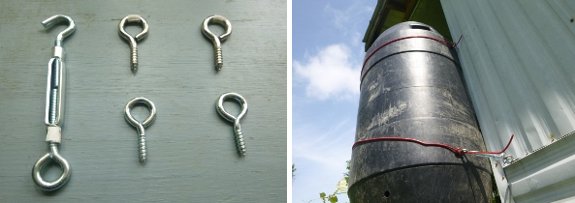
4 eye bolts with a cable and
a turnbuckle was what it took to mount this rain barrel.
Total cost was under 10
dollars.
This PVC frame will be a new chicken tractor to replace the primitive chicken tractor we are still using.

There are as many kinds
of writers' retreats as there are writers, and when I started
researching I considered just about every option. But, in the end, I
decided to keep it simple --- find a hotel room within two hours' drive
that's close to some natural area I want to explore. Beech Mountain,
North Carolina, topped the list both literally and metaphorically.
After all, the highest incorporated town east of the Mississippi is so
cool in the summer months that no one even installs air
conditioning. What's not to like?

My condo at Pinnacle Inn
was quiet and tranquil...although my rural-accustomed eyes would have
preferred the streetlights to be quenched at night. Other than that,
though, the location was quite a treat, and I split my days between
pounding out chapters about werewolves and hiking stunning trails (the
latter of which I'll tell you more about in tomorrow's post).
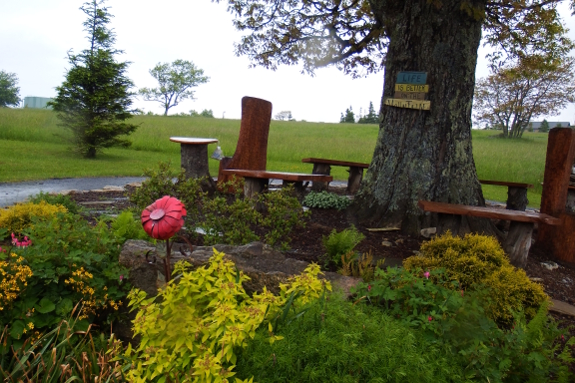
In the online circles I
frequent, I'm a bit of a slow writer, publishing only four novels per
year. And up on the mountain, I realized that if I changed my daily
routine, I could easily double or triple that output. It's just so easy
to write when nothing distracts you from the fictional world you're
spinning within your own mind, when a hike in the middle of the day
helps plot threads weave more closely together and when there are no
husbands or animals or gardens to feed and enjoy.
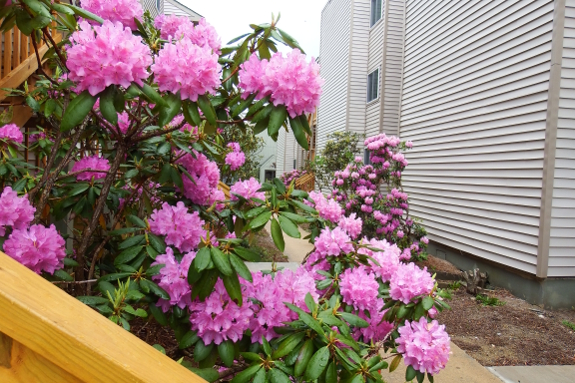
On the other hand, I
missed my husband and animals and gardens like the dickens, and the
very best moment of the retreat was when I hiked back into our farm to
greet Mark with a hug. I'm pretty sure I'll line up more writers'
retreats in the future, both for the productivity boost and for the
mental clarity that comes from four-mile hikes combined with 4,000-word
days. But I wouldn't want to live there --- I prefer to merely visit.
Thanks for all the useful
comments on my Harbor
Freight solar panel post. I need to learn more about MPPT charge
controllers.
I especially liked Harry's
idea of charging up our two best 6 volt golf cart batteries with a 120
volt battery charger.
The next test will be to see
how long my 12
volt fan will run on a full charge.
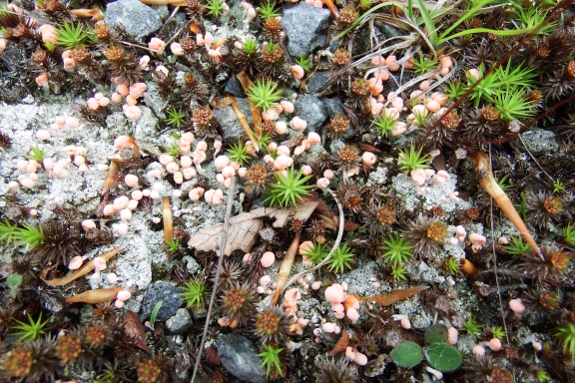
When I wasn't writing, I
spent most of my time on Beech
Mountain visiting the town-owned park called the Emerald Outback.
Located near the peak of the mountain, this beautifully laid out trail
system provides stunning vistas both large and very small. Shown here
is mosses, lichens, and fungi hiding in the gravel at the edge of
Bailout Road, a gravel track that runs down the center of the park for
easy and quick trips home once you wear yourself out on the more
woodland paths.

Weather up there changes
on a dime, so be prepared. I visited twice for a few hours apiece, and
in that five hours or so spent on the mountain I enjoyed blazing
sunshine, pea-soup fog (which I'm pretty sure was actually low-lying
clouds), and a brief storm. Based on the height of the main canopy ---
probably no more than twenty feet above the ground --- and the
windswept appearance of brave emergents, I suspect the park often sees
pretty windy conditions as well.

 Over much of the Emerald
Outback, the forest floor is lushly covered by soft-leaved sedges that
remind me of a well-managed pasture. Boulders are common as well, and
in several places the trees perch on the edge of rocks as if they sat
down to rest for a spell and forgot to get back up.
Over much of the Emerald
Outback, the forest floor is lushly covered by soft-leaved sedges that
remind me of a well-managed pasture. Boulders are common as well, and
in several places the trees perch on the edge of rocks as if they sat
down to rest for a spell and forgot to get back up.
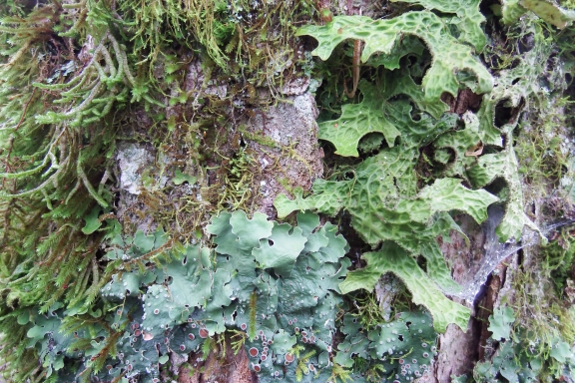
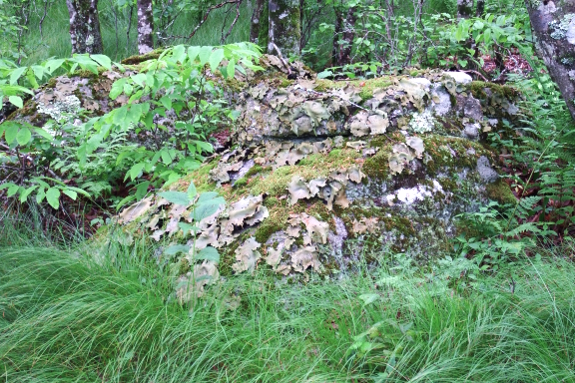
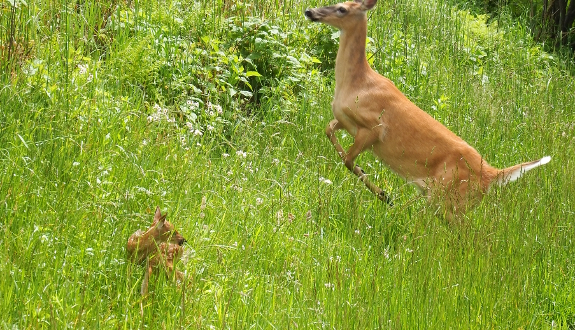
 Wildlife includes tremendous
numbers of deer --- I think I saw more than a dozen during my first
hike. The astute visitor will probably also notice juncos, which are
winter residents at lower elevations but stay year-round on the
mountain in order to raise their young.
Wildlife includes tremendous
numbers of deer --- I think I saw more than a dozen during my first
hike. The astute visitor will probably also notice juncos, which are
winter residents at lower elevations but stay year-round on the
mountain in order to raise their young.

If you're more into the
big picture, the Southern Ridge Trail includes three overlooks, the
last of which is the best. Blueberries all along the trail, but
especially at this final overlook, were just beginning to set fruit
when I visited, so I'm guessing you'd get a trailside nibble if you
hiked the mountain in late July or early August.

All-told, this is one of
the most beautiful parks I've been to in a long time! Plus, I could
walk to the entrance from my hotel, which made for a perfect commute.
If you're interested in following in my footsteps, you can read more about the
Emerald Outback here.
We had some car drama this
week involving a transmission failure.
Luckily it was a leak in the
fluid intake which our local mechanic fixed.
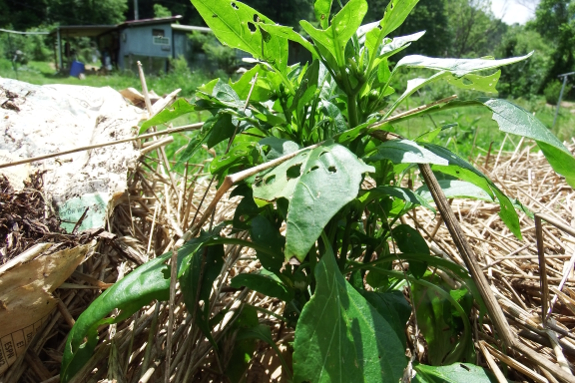
"How
did your peppers do with the half composted goat manure? Was it not too
hot?" Becki
Wilson asked, before going on to explain that she has access to fresh
--- but not composted --- manure and wants to garden now.
First of all, I should
say that the
half-composted goat manure I was using tends to have the opposite
problem. When the most volatile nitrogen has leached away and the
majority of the organic matter hasn't yet broken down, what I tend to
see is plants yellowing from lack of nitrogen rather than getting
burned from too much. That was indeed the case for the first couple of
weeks for our peppers, but they seem to be greening up and growing now
(as long as the slugs will leave them alone!)
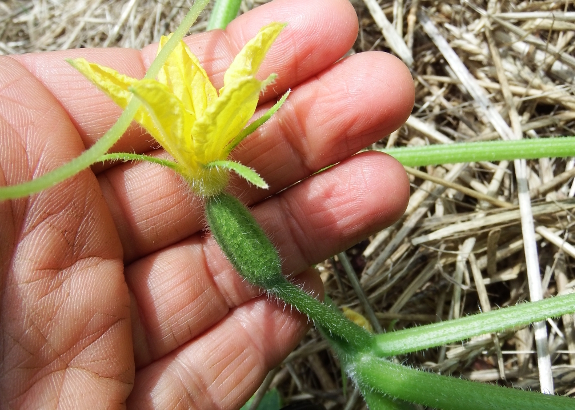
Answering Becki's
question about her own garden is a bit more complicated. Different
types of manure have different strengths --- chicken manure, for
example, is very hot and I'd be leery of using it close to most living
plants when fresh. Topdressing about a foot away from newly planted
seedlings is generally okay, though, because by the time the roots grow
out into the impacted soil, the manure has broken down enough to be
helpful rather than harmful to their growth. But use more than you
think you need with fresh manure because you will hit that low-nitrogen period
in the middle and want your plants to have enough nutrition to survive
the gap.
If you need more
in-depth information on using manure in the garden, my Ultimate Guide to Soil contains a
whole chapter on the topic. Good luck...and I hope your new garden
grows fast and luxurious!
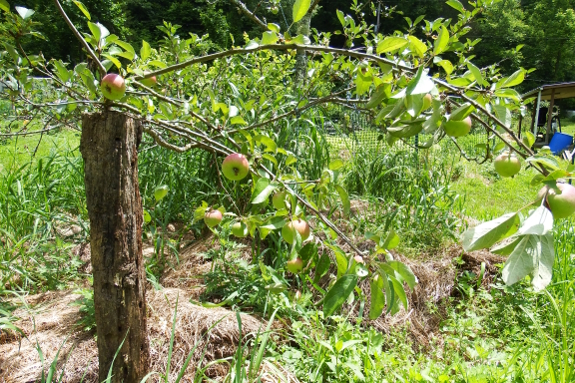
Last year, we ate one
apple off the small
branch of William's Pride I grafted onto a Virginia Beauty tree in
February 2013. There would have been two...but a deer walked through
the garden and stole the second fruit (eating almost nothing else!) in
a move reminiscent of one
of the most memorable books I had as a child.
This year, there are so
many apples on that one small limb that I had to prop it up on a log to
keep it from bending to the ground. With a solid month to go before the
fruits are due to ripen, I'll have to keep an eye on our borders and
hope the deer don't make a reappearance.
Our sweet corn is a little over knee high thanks to a layer of cardboard and straw.
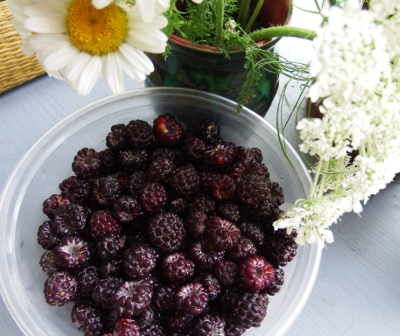 We never have quite enough
bird pressure to make it worth the daily annoyance of raising and
lowering netting on our berries, but some years individual fliers are
worse than others. This has been one of the worse years, so I've been
picking our berries a little underripe to beat the birds. The fruits
are still delicious when topped with whipped cream!
We never have quite enough
bird pressure to make it worth the daily annoyance of raising and
lowering netting on our berries, but some years individual fliers are
worse than others. This has been one of the worse years, so I've been
picking our berries a little underripe to beat the birds. The fruits
are still delicious when topped with whipped cream!
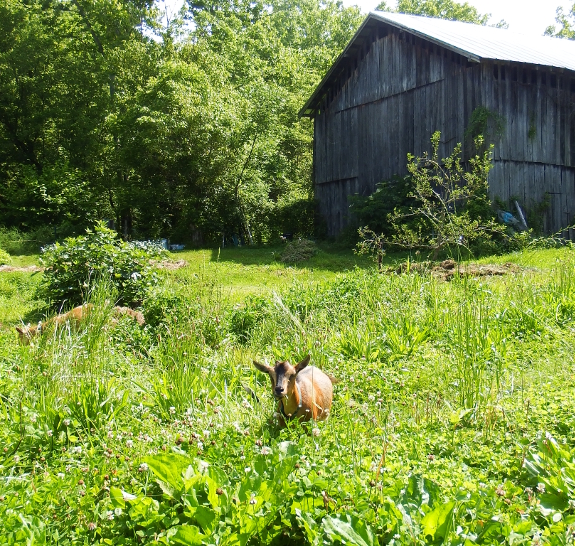
This is the time of year
when any mistake you made in the garden amplifies by the second. If,
like me, you left last year's mistakes alone to be dealt with later,
your garden may look more like a weedy lawn than a growing space. (At
least the goats are impressed!)
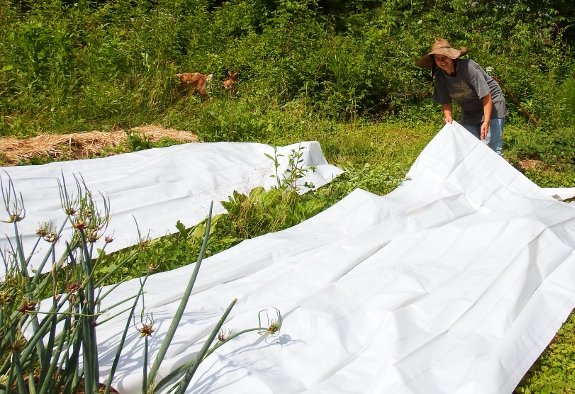
Conventional gardeners
fix these troubled spots by tilling (and maybe tilling again). I'm
instead solarizing some areas, kill mulching others, and (for the easy
spots) hand weeding and following up with cover crops (buckwheat and
soybeans). I cover the first two of these methods in Small-Scale Gardening Basics and the
last in Homegrown Humus if you
want to follow my lead.
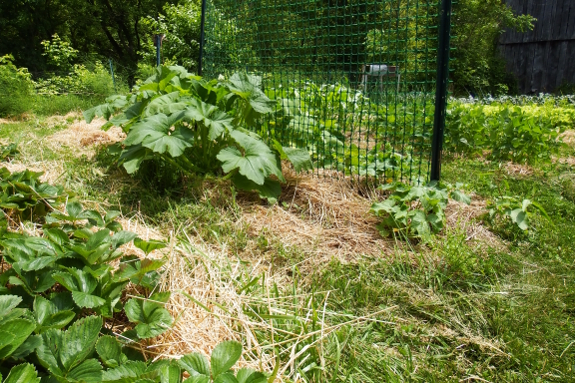
Then, once the garden is
reclaimed, I mulch heavily to maintain my tenuous win over the weeds.
Win, lose, or draw, I generally get at least some harvest, plus many
beautiful mornings in the garden to boot...so I guess it's really
always a win.
This post is to remind us to
apply for absentee ballots before the deadline.
Our local election board
seems to have switched back to a paper ballot machine.
I was only the 8th person to vote as of 10:45 am.
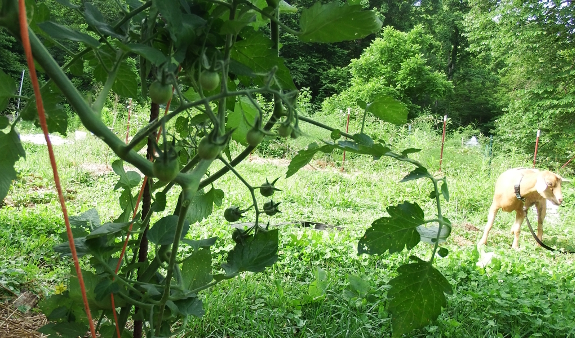
What do goats and
tomatoes have in common? When you raise them by the dozen, it's all
about a herd mentality --- damage control. But with just a few on the
farm, each one turns into a cosseted and cared-for pet.
This year, we have four
pet tomatoes rather than our usual three dozen. With so few looking for
homes, I was able to chose niche habitats for each. Two are beneath our
west-facing roof overhang and got trained
along strings while
the other two are in a more conventional garden setting. I'll be
curious to compare and contrast which setting does better when the time
comes to harvest from our pets.
The egg eating has seemed to
scale back to every other day for some reason?
We are pretty sure they are
getting plenty of calcium.
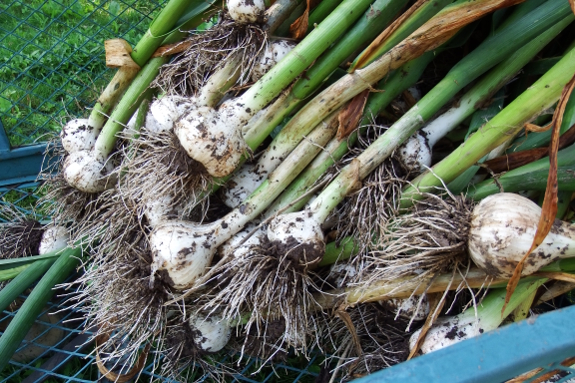
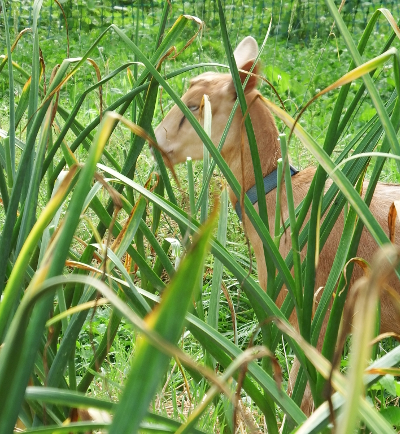 When the garlic plants are no
longer lush and beautiful, it's time to think about harvesting. (You
can see all of my tips on when to harvest garlic here.)
When the garlic plants are no
longer lush and beautiful, it's time to think about harvesting. (You
can see all of my tips on when to harvest garlic here.)
This year, Aurora and
Edgar "helped" me with the harvest. Apparently, garlic leaves are a
good garnish after a morning spent grazing on clover and plantain. I
guess I should have tethered the herd just a little further out of
reach....
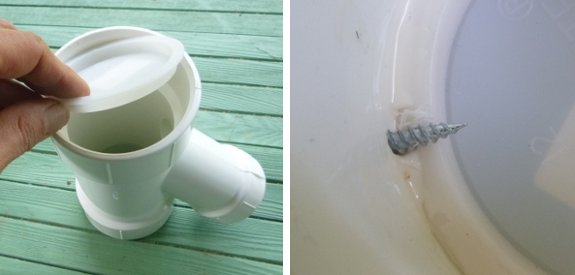
I decided to upgrade our PVC
chicken feeder to a 3 inch pipe diameter with a wye fitting where the
chickens eat the feed.
The plastic lid fits into
place but needs to be secured with screws.
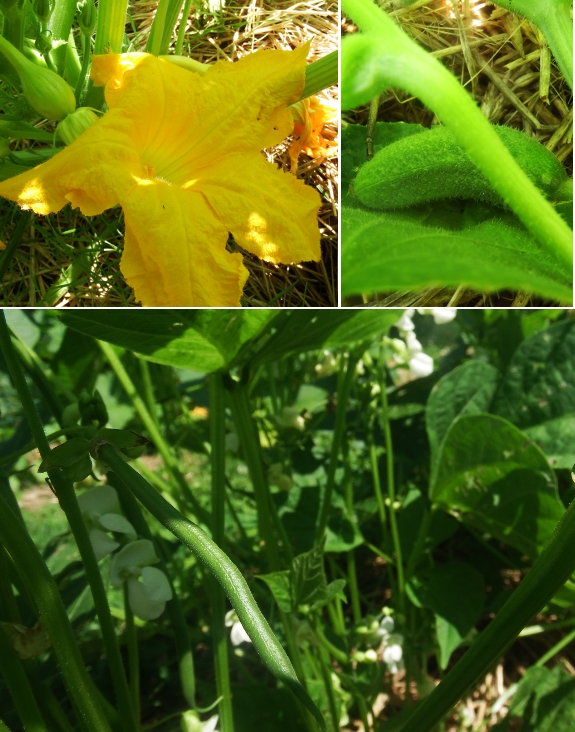
I like to have at least
two dependable vegetables on the menu so we don't get bored eating the
same one over and over. As a result (and despite what
I said in my recent blog post), I've waited to pull out
our broccoli, letting it put out the first round of side shoots instead.
The pea vines, on the other
hand, hit the compost pile yesterday and the last bed of lettuce is
really too bitter for the gourmet palate. Good thing we're already
nibbling on carrots and will be enjoying green beans and cucumbers by
this time next week. The summer dining season is nearly upon us!
The new PVC chicken feeder is a 3 inch pipe with a 2 inch opening for feed.
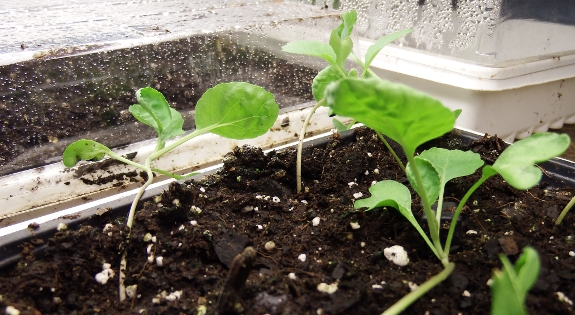
With
the spring garden nearly done and the summer garden beginning to produce, it's time to think ahead to
autumn. We started the first round of brussels sprouts inside two weeks
ago and this week we planted a flat of broccoli (with a few more
brussels sprouts at one edge). By the beginning of July, we'll be
direct-seeding the first fall crops (carrots), and so the wheel of the
seasons continues to turn.
We were a little unsure about
using white
plastic for solarization of weeds.
After 4 days of sun it seems
to have begun the job of baking the weeds to death.
We liked this plastic because it was thick and cheap and should endure
several applications..
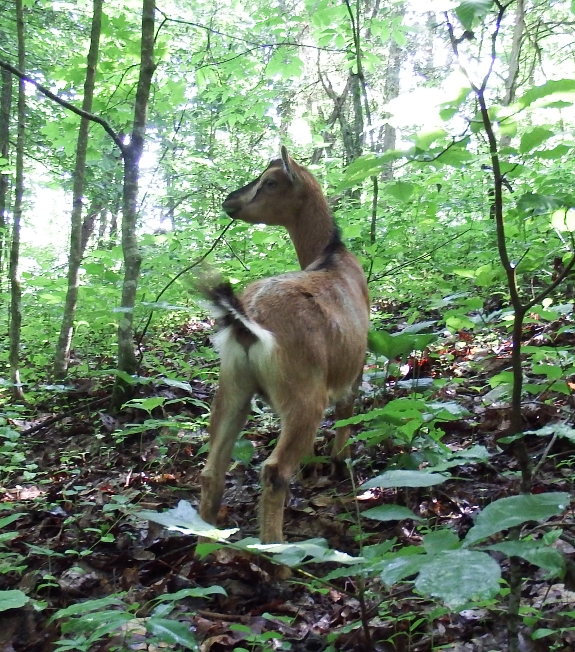
I realized it's been two
full months since I gave you a
progress report on Edgar. Without lice to rough up his fur, our new
wether sleeked down and developed moonspots!
Meanwhile, while I was
gone on my writing
retreat, Mark bonded so thoroughly with Eddie that our wether
turned from a pretty-good goat into someone who gives Aurora a run for
her money in the resposive-and-loving department. During those same
three days, the last clumpiness of his poop and even part of the
troublesome coughing disappeared --- clearly I just needed to let Mark
at our newest herd mate sooner.
All told, Edgar is an
excellent playmate for Aurora and me. He comes when he's called, is
less of a prima donna than his "sister," and is always cheerful and
ready to eat. Now, if I could just get him to stop peeing on my gear
when I'm out enjoying the woods with the herd...but maybe that's just
the goat equivalent of leaving the toilet seat up?
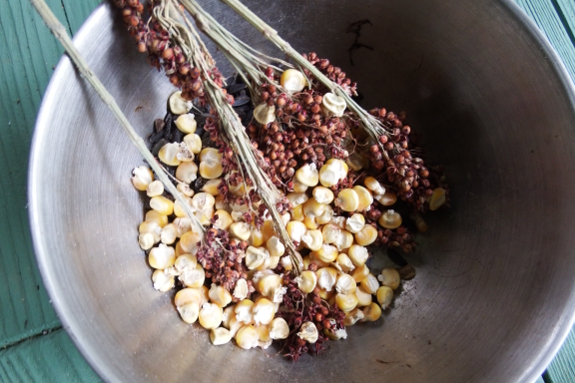
The trick to a smooth
goat hoof-trimming session is high quality bribes. Since neither Aurora
nor Edgar is pregnant or lactating, they're currently getting no
concentrates. So a bowl full of homegrown sorghum and field corn once a
month definitely gets their attention.
For best results, leave
the sorghum on the stalk so it takes longer to scarf down. Spoiled
goats may or may not decide that corn on the cob is worth the hassle....
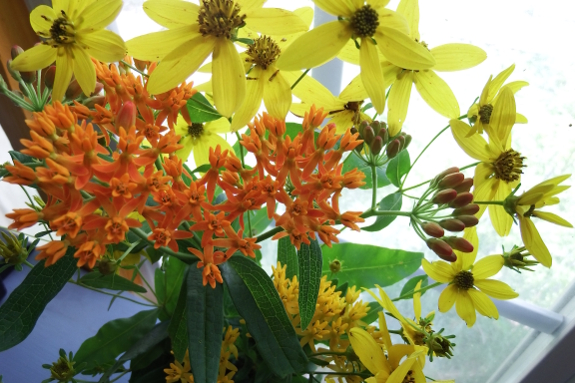
The Summer Solstice ---
the longest day of the year --- will be tomorrow...and, as usual, I
can't think of a really adequate way to celebrate. I always love the
idea of jumping over a bonfire...then the reality of sunset falling
near my bedtime when it's still hot out kicks in. Maybe I need to learn
a sun dance or practice some sun salutations instead?
What's your favorite way
to celebrate the solstice?
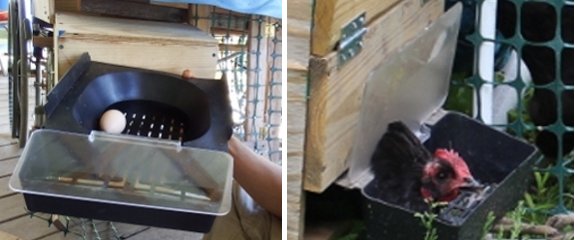
What about the design should
change to prevent hens getting to the eggs?
Thanks for the question Kaat.
It might be possible to glue
an extension to the tray to keep eggs out of reach?
We go back and forth about
deleting the two or more hens who are eating eggs.
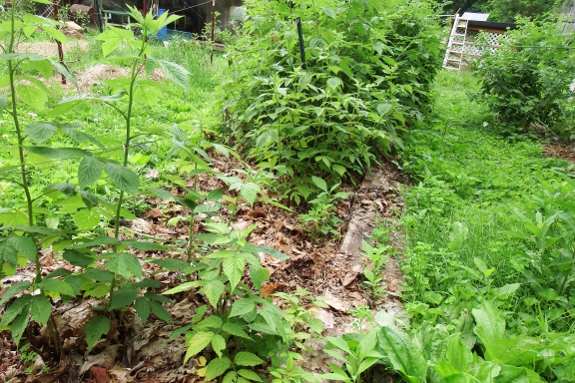
I never thought of
raspberry patches as coming with an expiration date,
but last year I realized that all good things must come to an end.
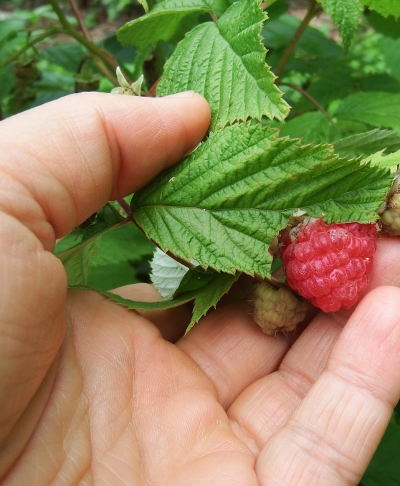 Our
everbearing red raspberries started as a single freebie thrown in by
Raintree in 2007 when we ordered several fruit trees. Now, a full
decade later, that singleton has expanded
into two patches on our own farm plus several in the gardens of family
and friends...but the original planting is finally starting to lag. In
the photo at the top of this post, the dividing line between the
summer-bearing
raspberries (begun as one plant three years ago, background) and the
ever-bearing raspberries (ten years old, foreground) is startlingly
clear.
Our
everbearing red raspberries started as a single freebie thrown in by
Raintree in 2007 when we ordered several fruit trees. Now, a full
decade later, that singleton has expanded
into two patches on our own farm plus several in the gardens of family
and friends...but the original planting is finally starting to lag. In
the photo at the top of this post, the dividing line between the
summer-bearing
raspberries (begun as one plant three years ago, background) and the
ever-bearing raspberries (ten years old, foreground) is startlingly
clear.
Luckily, the solution is
neither difficult nor expensive. This fall, we'll buy another single
plant of an ever-bearing variety (or maybe several if I'm feeling like
a spendthrift) and we'll be rolling in spring and fall berries in no
time. So despite their expiration dates, ever-bearing raspberries
continue to make the cut as one of our easiest and most
dependable fruits.
Trimming Aurora's hooves is
easy as long as Edgar is occupied with treats.
Edgar requires me to hold him
down while he's being trimmed.
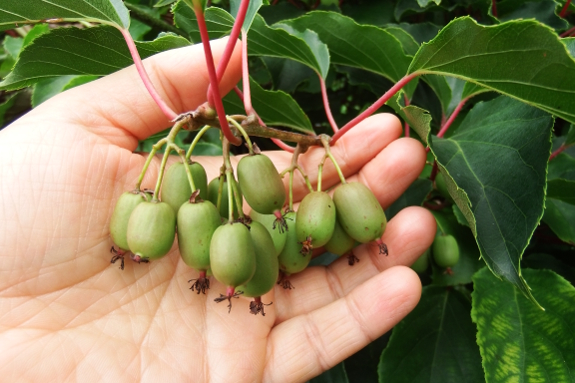
Look who's getting
bigger by the minute! Our Ananasnaya hardy kiwi has at least a dozen
clusters of fruits this year for the first time ever and they're
plumping up nicely. So I headed to the internet to look up when the
fruits will be ready to harvest.
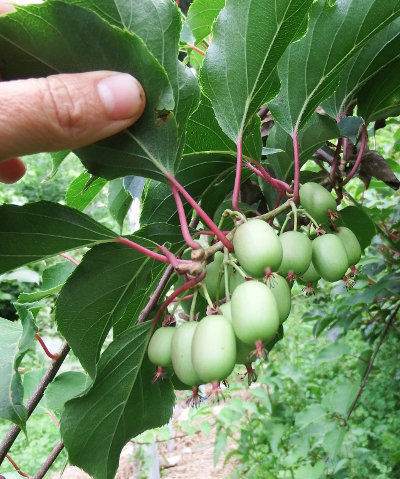 The answer is that we may run
into the same trouble on the harvest end as we did on the flowering end
--- frosts. Depending on the source, I've seen reports of hardy kiwis
ripening anywhere between July and November, but you definitely have to
bring them in before hard freezes hit.
The answer is that we may run
into the same trouble on the harvest end as we did on the flowering end
--- frosts. Depending on the source, I've seen reports of hardy kiwis
ripening anywhere between July and November, but you definitely have to
bring them in before hard freezes hit.
To find out if your
hardy kiwis are ripe enough to pick, cut one open and look inside. If
the seeds are black, the fruits are ready to pick even if the flesh is
green and hard. These kiwis can be stored in the fridge for a couple of
months then taken out to ripen at room temperature a few days before
you want to try them out.
Alternatively (if
there's time), you can let the hardy kiwi fruits ripen on the vine.
Vine-ripe fruits will become soft and most will blush red. If picked at
this stage, though, you'll have to eat them up quickly because they
won't last long in storage. Sounds like such a hardship! I can hardly
wait....
Anna likes to clear her head
from long hours of writing with berry picking.
It takes her somewhere
between 5 and 10 minutes to pick a nice size bowl.
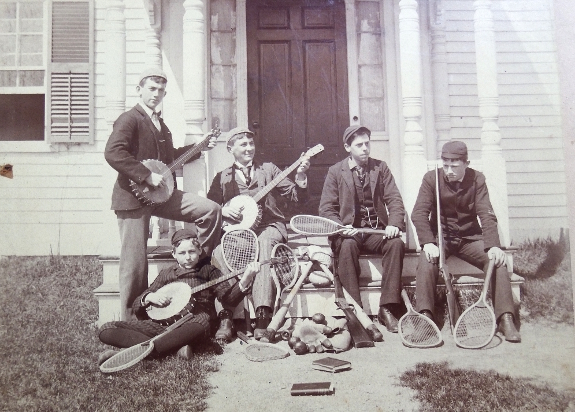
Mom came over Thursday
with some old family photos, of which this is my very favorite. My
great grandfather (lower left) was apparently a prep school boy in
1891. As the youngest in his house, Mom informed me that Prince Henry
(yes, that was his first name; no, he wasn't a prince) was made to run
errands for everyone else. So maybe the pout isn't feigned?

Fast forward ahead
forty-odd years and the pouting school boy's daughter was adventuring
in Panama. You
can jump forty more years into the future to see the canoer's daughter
(my mom) in this post.
And then check out most of this blog to see the next generation (me)
nearly forty years after that. How time flies when you're having fun!
It's been a year and a half
since our Celeste
Fig got too cold and died back.
If we think of something
better for this spot it might get pulled up.
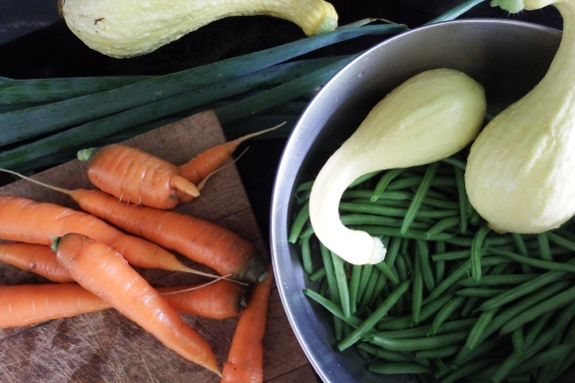
I finally pulled out the
broccoli now that the summer crops are coming in. Beans, squash, and
cucumbers pick up speed fast once the first harvest happens, so we
won't have room in our bellies for much else for the next little while.
Time to enjoy the bounty of summer!

Mark will be getting
home shortly from his annual visit to Ohio, so I thought I'd give him a
break and post in his place. A huge Thank You! to Rose Nell and Jayne
for helping him track down a 2005 Corrolla to replace our old 1994
Corrolla. And, of course, for the usual wonderful food, fun, and
fellowship. We love you guys!
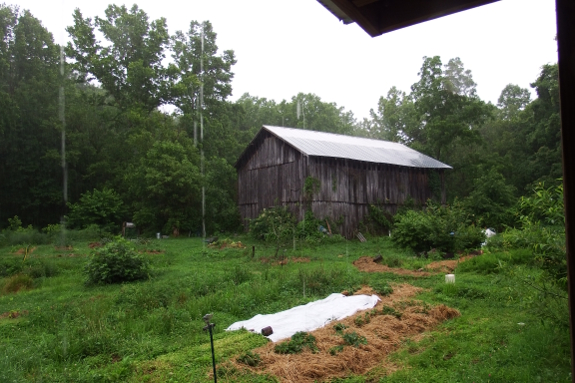
Despite its hot, early
start, this summer has since turned wet and cool. We've seen rain for
15 of the last 30 days, adding up to a bit over 7 inches ---
nearly double our usual average.
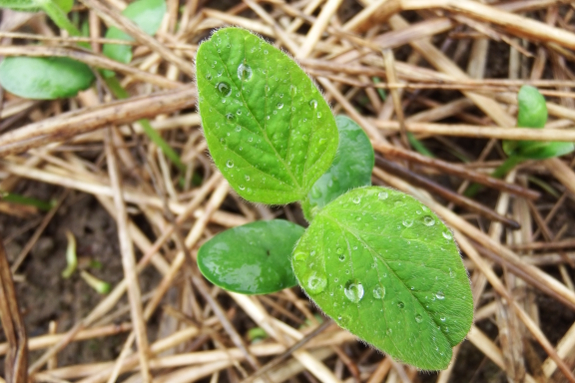
So what do gardeners do
during a wet summer? Watch plants grow slower than usual. Snip off
blights as soon as they form so the fungal diseases don't spread to
take out your entire planting. If you've got spare compost or manure,
topdress to replace the leached nutrients. Barring that, plant
nitrogen-fixing cover crops like soybeans so at least the next
generation will be adequately fed.
On the plus side, at
least we haven't had to do much watering this year!
Thanks for all the thoughtful
comments on our egg
eating roll out nest tray issue.
We decided to go with the
light blocking experiment to see if that helps.
If it works I'll make
something more rainproof.
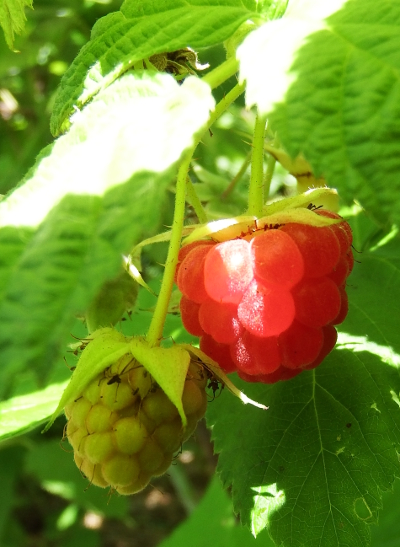 A few of you asked why we'd need
to start our ailing
raspberry patch from
freshly purchased stock rather than just digging up new shoots the way
we've done to expand it in the past. The short answer is --- viruses.
A few of you asked why we'd need
to start our ailing
raspberry patch from
freshly purchased stock rather than just digging up new shoots the way
we've done to expand it in the past. The short answer is --- viruses.
Over time, viruses tend
to build up in both raspberries and strawberries, causing declining
vigor that carries over to any offshoots you propagate using homestead
methods. Reputable nurseries instead rely upon lab techniques to clone
without allowing viruses to come along for the ride, resulting in
certified virus-free stock.
So if your patch starts
ailing for no apparent reason, a fresh start can be worth a few bucks
of nursery stock. Be sure to plant in a new location so the diseases
won't spread quickly to your new plants and you should get many more
years of raspberry for relatively little effort or expense.
The first day of blocking the
light on the roll out nest tray failed.
There might still be some
light leaking in from the top that I can block.
We took the day off to see
the Solar Eclipse planetarium show at Bays Mountain.
It was a good primer for the
upcoming event in August.

My first barge ride in
many years.... The boat has been upgraded, the phoebe is still nesting
in the rafters, and all I had eyes for was waterlilies.

Spatterdocks and water
shields....

Light on water
and ovals of chlorophyll....

Down the hatch!
We tested the driveway again
today and proved it's still too wet here.
The good news is our first
time using the winch on the rear hitch receiver worked without any
problems.
Our new plan is to seek
someone local with some equipment and experience in driveway building
that does small to medium sized jobs like this.

Previewing the eclipse
at the planetarium got us fired up about coronas and Baily's beads and
diamond rings. Only seven and a half weeks until E Day!
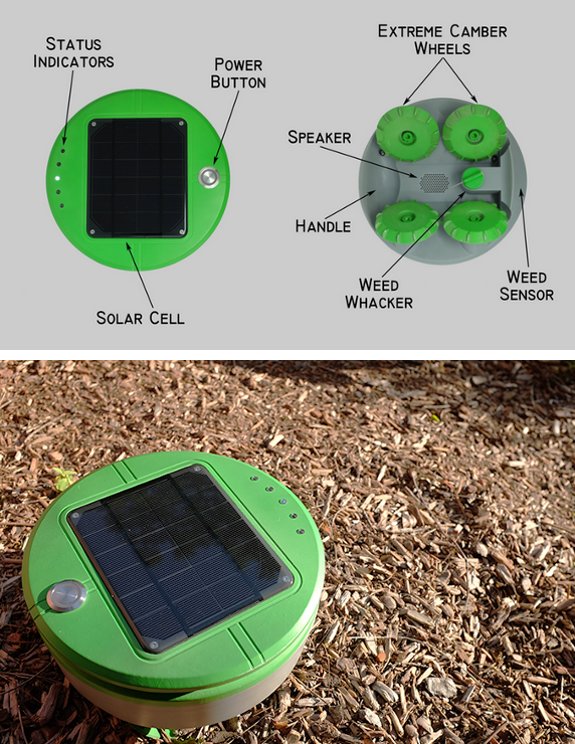
The inventor of the
Roomba-Joe Jones has invented a Roomba
for weeds.
It seems like a serious
product for someone with the right size garden.
Maybe weeding the garden in
the future will be more about robot repair and less about kneeling
down and pulling up weeds?
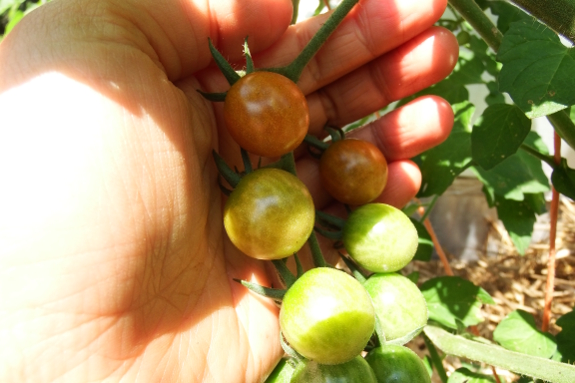
Want more in-depth information? Browse through our books.
Or explore more posts by date or by subject.
About us: Anna Hess and Mark Hamilton spent over a decade living self-sufficiently in the mountains of Virginia before moving north to start over from scratch in the foothills of Ohio. They've experimented with permaculture, no-till gardening, trailersteading, home-based microbusinesses and much more, writing about their adventures in both blogs and books.
